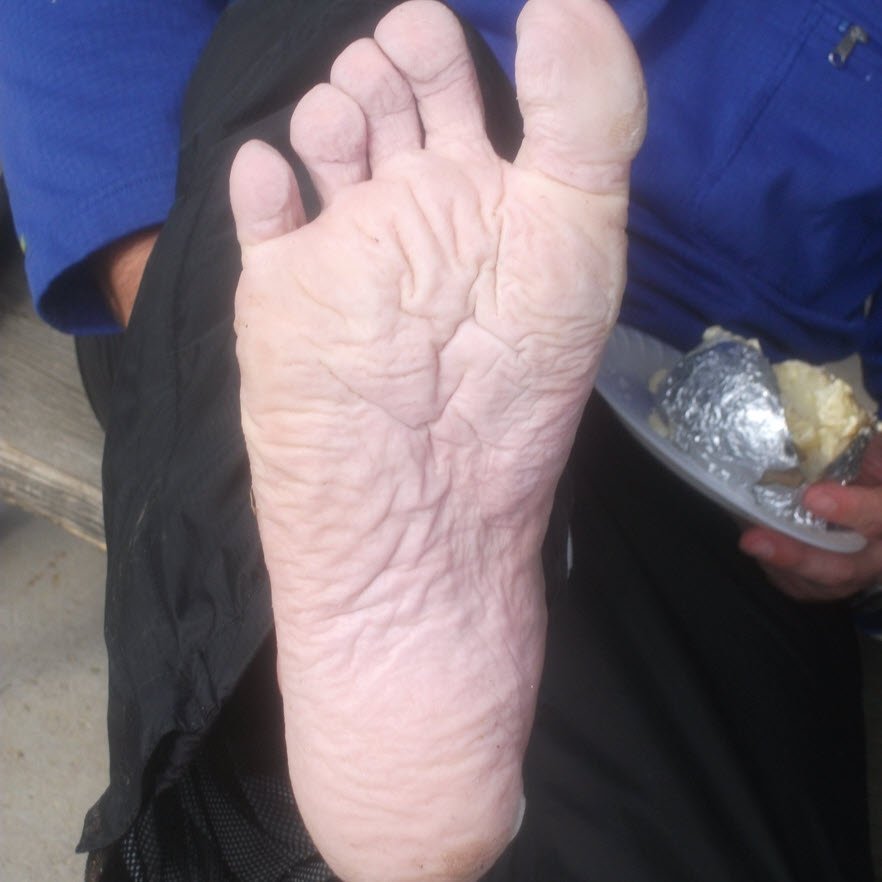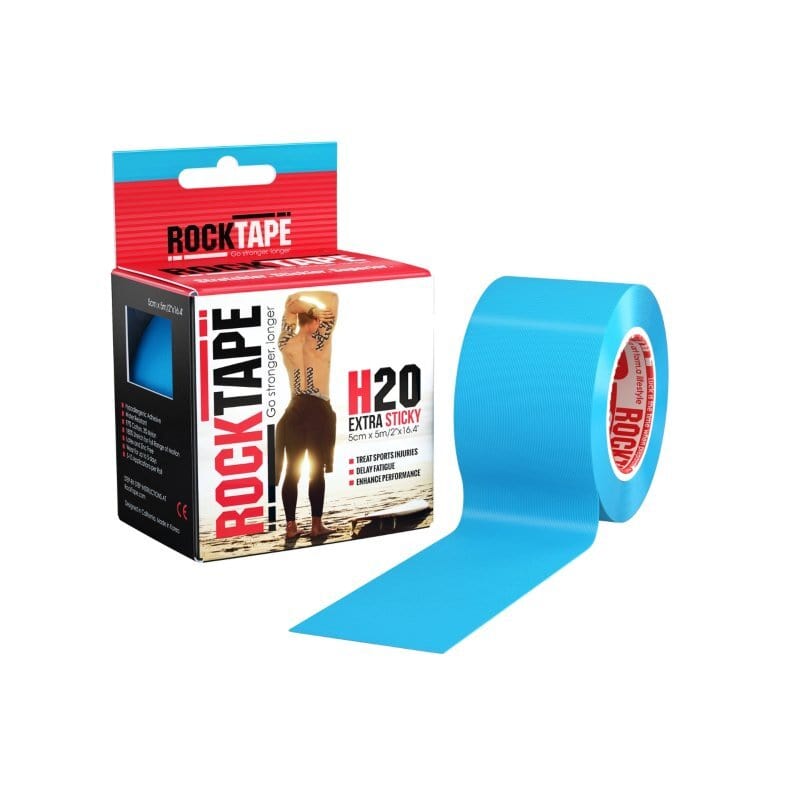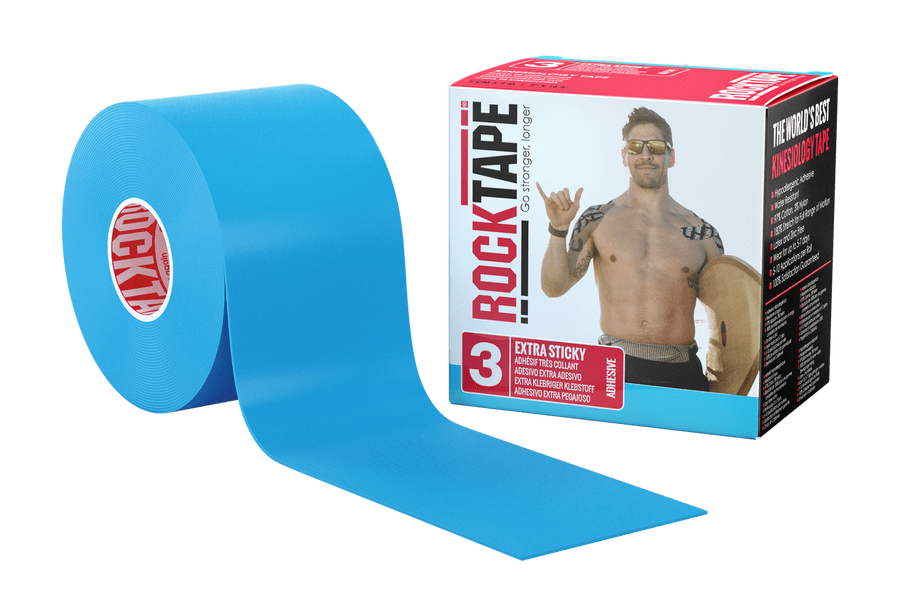Preventing soggy macerated feet is all about keeping your feet dry. Dry from water coming into the shoe from the outside (environmental water - puddles, rain, dew, river-crossings, water tipped over the head which runs down the legs and into the shoes). And dry from intrinsic sources of moisture, like sweat. To be sure, preventing maceration is easier than treating it!
First of all, I apologise for the length of this article (5,300 words). To help get your bearings, here's an outline of this post:
Prevention Overview
Moisture-management in the athletic and wilderness arena: A quick look at current opinion on methods to prevent maceration.
What’s worse? Moisture from perspiration or environmental water? We'll look at the relative harm these two sources of moisture (perspiration and environmental water) can do. With the help of an experiment at my local hydro pool.
What shoes and socks to wear to keep your skin dry (8 factors): We'll look at moisture-wicking socks, waterproof socks (with testing of several pairs for waterproofness and water-holding), water-resistant shoes, breathable shoes, freely draining shoes and a couple of basic precautions.
What topical products to put on your skin to keep it dry: We'll take a look at topical applications including solutions, lotions and shake lotions, creams, ointments, gels, powders, pastes, tinctures, film-forming liquids and waterproof tapes that can help keep the skin dry. And we'll think critically at how effective can we expect topical products to be?
What does the perfect maceration prevention strategy looks like? A summary of your options for preventing trench foot depends on the environmental conditions, the specifics of your activity and the gear you have available to you.
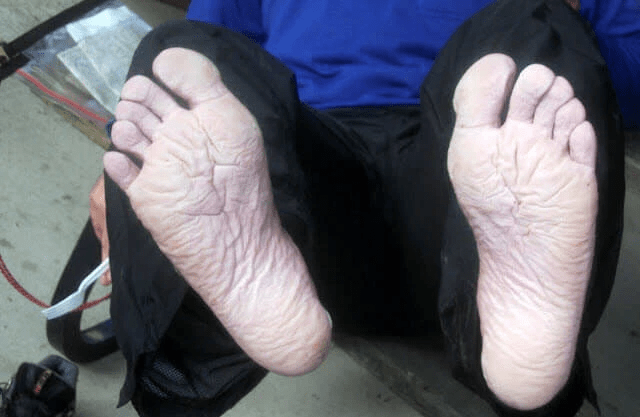
Soggy macerated feet: https://team-virtus.com/tag/macerated-feet/
Maceration and moisture-management in the athletic and wilderness arena
Man of many talents and accomplishments from Event Safety Services, Lucas Trihey provides insight based on his experience as technical adviser to an outdoor/adventure retail chain over many years. His gear testing of shoes and socks have him believe that for mild or warm climates, a lightweight breathable shoe is a good option. These would let water in but would also dry quickly. This seems to work better than a "waterproof" shoe that would:
1. Fill with water if it got really wet (heavy rain or a creek crossing); and
2. Inhibit the escape of perspiration, promoting wetter socks and wetter feet.
Similarly, backpacker Brian Green suggests in his [GORUCK Challenge blog post“You don’t want boots or shoes that are water proof or coated with a product designed to keep water from getting into your shoes from the outside. That protective coating is actually going to keep the water *in* your boots or shoes and make matters worse. You want footwear that can drain.” Ultrarunners competing in multiday events in soaking conditions and tropical locations have been known to pierce holes into their shoes to allow water to drain freely.
What’s worse? Moisture from perspiration or environmental water?
In preventing maceration, the idea is to facilitate the movement of bodily and environmental moisture away from the skin and out of the shoe. Or to stop environmental water from getting into the shoe or sock altogether. But if circumstances dictated choosing one at the expense of another, which source of moisture is worse and worth avoiding the most? _Is_ one worse than the other?
There is a commonly-held view that maceration from environmental water is more damaging than maceration from sweat. An explanation for this observation has been in the forefront of my mind while researching this article. I have assumed the reason is because of the sheer volume of water – environmental sources can deliver larger quantities into the shoe compared to perspiration. But before now, I’ve not thought that deeply about it. The answer could help athletes prioritise the selection of fabrics and gear to be worn or the use of pharmaceutical products applied to the skin, depending on the condition of the day.
An experiment
I conducted a basic experiment to gain insight into the effects of waterproofing the skin. Rehabing after a hip operation, I’ve been at the hydro pool a lot lately. My fingers get wrinkly by the end of my one hour session. So I taped one fingertip* with Opsite**, rendering that skin unexposed to the pool water, but exposed to the same water temperature (35 degrees Celsius) as well as to perspiration from my exercise in this warm and humid environment.
The skin on the hand’s palmar surface is known to be comparable to that of the foot’s plantar surface.
Opsite FlexiFix is a thin clear dressing that is water-proof from the outside, but semi-permeable from the inside. Although the Opsite dressing allows the evaporation of moisture via its “high moisture vapour permeability”, this will only occur where there is a moisture gradient (perspiration will only evaporate out if there is lower moisture on the other side of the dressing). Because my hand was permanently under water, I expect there would be no moisture movement from inside to outside. So one fingertip was going to macerate due to exposure to the pool water, the other was going to macerate due to the lack of evaporation of sweat.
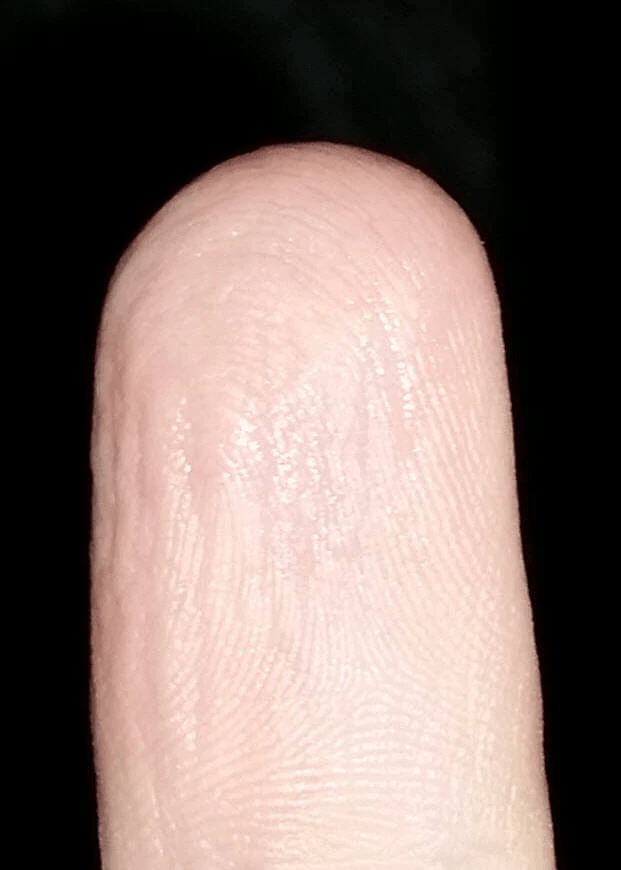
Uncovered fingertip of my right ring finger
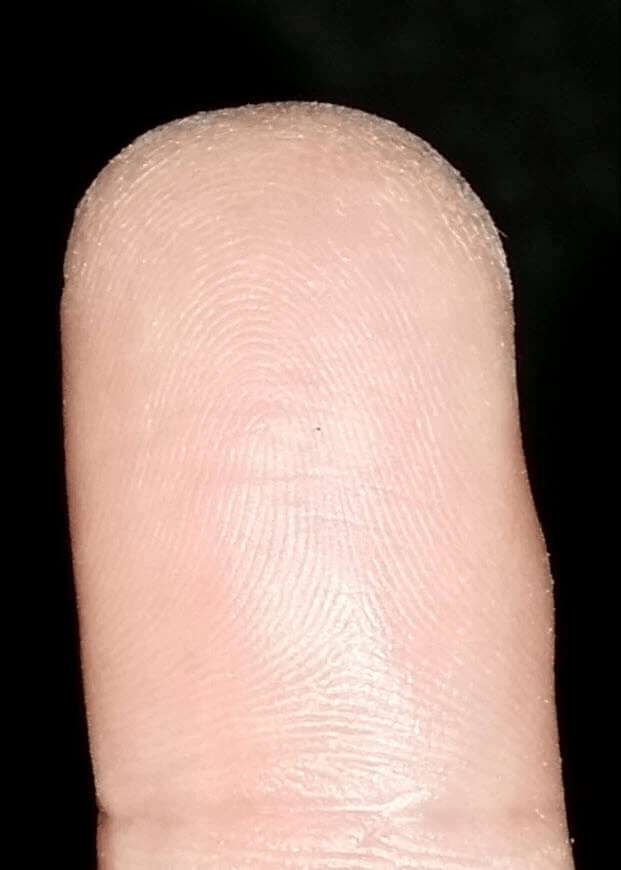
Covered fingertip of my right middle finger
The photos show my uncovered fingertip (left) was macerated and the covered fingertip (on the right) was not. The exposure to pool water impacted the skin much more than the lack of evaporation of sweat did, over the course of that hour.
Limitations:
1. One hour is a relatively small period of exposure.
2. Chlorine is not present in running and hiking situations.
3. I’m not a very sweaty person and my exercise intensity was moderate at most. Higher volumes of exercise and perspiration would have been more indicative of the in-shoe situation.
Getting back to the theory of environmental water exposure being more damaging than perspiration … Could it be as simple as the sheer volume of water the skin is exposed to? Or does sweat contain elements that are protective to the skin? Or is there some other reason why environmental water is more damaging than perspiration? Is the observation even valid?
The question remains unanswered. But if the theory holds true, the conclusion one could make here is that if you have to make a choice between using gear and products that prevent the evaporation of sweat, versus using gear and products that allow unrestricted contact of environmental water with the skin, the former is the more favourable choice, at least for relatively short periods of exposure. Better still, find a strategy (or combination of strategies) that achieves both.
What shoes and socks to wear to keep your skin dry
Let’s look at some strategies around shoe and sock selection:
1. Moisture-wicking socks
Moisture-wicking socks move sweat away from the skin. They are a recommended strategy for sport and endurance events. At its simplest, moisture-wicking means no cotton (read this article for more). But here’s something to think about - the absorptive capacity of any moisture-wicking sock will be exceeded when it and your shoe become water-logged. At that point, it will stop moving moisture away from the skin as there is no longer a moisture gradient to facilitate this transport. Moisture-wicking socks work best when:
- Water can drain from the shoe
- Moisture can evaporate through the shoe upper
- The volume of moisture is not excessive
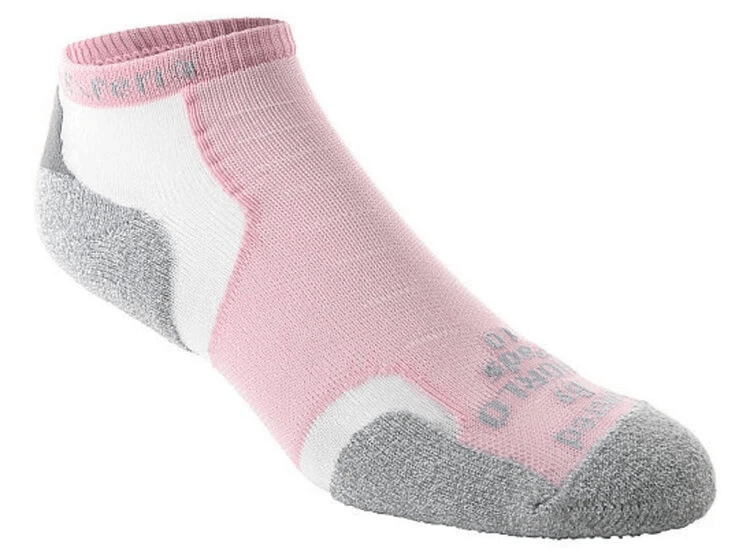
Thorlo moisture-wicking socks
2. Waterproof socks
Do waterproof socks exist? Does anyone wear them? What does waterproof actually mean? To my way of thinking, a waterproof sock would be a sock that does not let environmental water pass through it. That way, no water from the outside will touch the skin, at all. That would be my expectation (I’m not sure what I expect it to do with sweat).
It’s easy to test waterproofness (in a crude kind of way) with the water balloon test. Fill a sock with water and hold it up to see if any water drains out. If the sock holds water like a water balloon, it’s 100% water-tight (waterproof). But waterproof to water moving from the inside to the outside ie: sweat. Now do the same test with the other sock but turn it inside-out. If the sock holds water like a water balloon, it's 100% waterproof to environmental water! Be sure to test water movement in both directions. Does water move in, out, neither, or both?
I’m cautious about the moisture-management claims of socks, particularly of waterproofness. It may be inadvertent, but some sock literature gives the impression of being “waterproof” as well as “breathable”. This would be the best case scenario, but I’m not sure a sock can deliver on both objectives. I tested several pairs of socks (with various moisture-management claims) including DexShell (2 pairs), SealSkinz (2 pairs), ArmaSkin and Thorlo Experia (unfortunately, I didn't get to test the Rocky Gore-Tex socks). Here are the results:
Test Sock 1) Dexshell Waterproof Trekking Socks
Link: http://www.dexshell.com/trekking.htm
Description: “Waterproof and highly breathable. Inherently moisture wicking performance inner.Mid weight Merino wool terry loop cushion pad running from toe to heel up to calf.”
Fibre content: Outer shell: 96% abrasion resistant nylon, 3% elastane, 1% elastics.
Interlining: Porelle waterproof breathable membrane. Inner sock: 40% merino wool, 40% anti-pilling acrylic, 20% nylon.
Water balloon test: Pass! Truly waterproof in both directions – no water moves in (will keep your feet dry from environmental water) and no water moves out (will lock sweat in). That is, except for the elasticised cuff, that’s not waterproof - water can get in here.
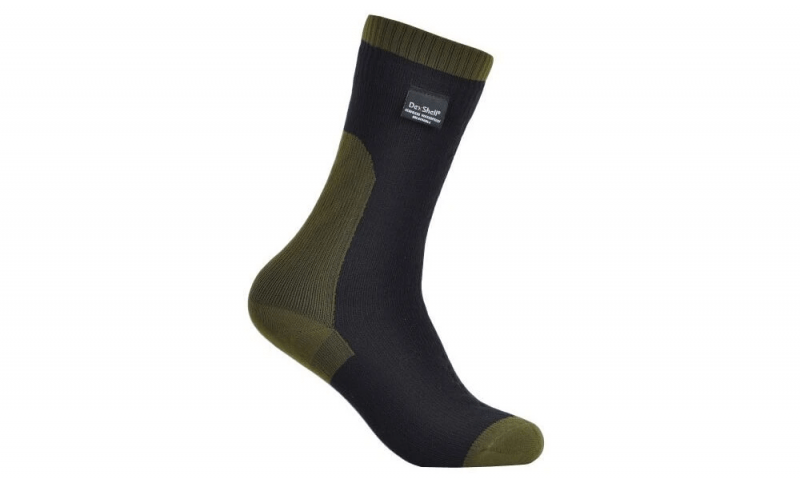
DexShell waterproof trekking socks
Test Sock 2) DexShell Waterproof Thermlite socks
Link: http://1046910846.wezhan.cn/product/276503244
Description: “Waterproof and highly breathable. Inherently moisture wicking performance inner. Light weight Merino wool for comfort warmth. This is an over ankle length, lightweight merino wool sock. Suitable for daily walking, hiking, and other outdoor activities in cold wet weather conditions."
Fibre content: Outer shell: 96% abrasion resistant nylon, 3% elastane, 1% elastics.
Interlining: Porelle waterproof breathable membrane. Inner sock: 38% merino wool, 38% anti-pilling acrylic, 24% nylon.
Water balloon test: Just as water-tight as the trekking sock. Truly waterproof in both directions – no water moves in (will keep your feet dry from environmental water) and no water moves out (will lock sweat in). That is, except for the elasticised cuff, that’s not waterproof - water can get in here.
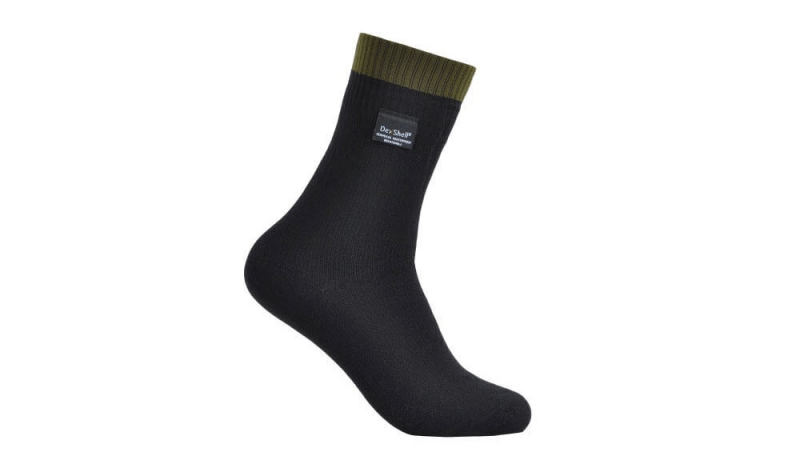
DexShell Thermlite waterproof sock
Test Sock 3)** SealSkinz Mid Weight Mid Length Sock
Link: http://www.sealskinz.com/UK/socks/mid-weight-mid-length-sock
Description: “Utilising proprietary 100% waterproof, breathable and windproof StretchDry technology this sock is perfect for a multitude of activities and conditions. Totally waterproof, breathable and windproof. Merino wool lining for moisture control & comfort. Elasticated ankle & insteps offer support and a comfortable fit. Mid weight sock offering the perfect balance of warmth and breathability.”
Fibre content: Outer Lining: 91% Nylon, 9% Elastane. Hydrophilic Membrane: . Inner Lining: 35% Merino Wool, 34% Acrylic, 28% Polyester, 2% Elastodiene, 1% Elastane.
Water balloon test: Like the DexShell socks, these are totally water tight (except at the cuffs). No water gets in, and no water can get out.
![SealSkinz Mid Weight Mid Length Socks]](https://www.blister-prevention.com/cdn/shop/files/SealSkinz_Mid_Weight_Mid_Length_Socks.png)
SealSkinz Mid Weight Mid Length Socks
Test Sock 4)** SealSkinz Women's Thin Socklet
Link: http://www.sealskinz.com/UK/socks/womens-thin-socklet
Description: “Thin weight socklet for a multitude of activities, where minimal insulation and maximum breathability are required. Totally waterproof, breathable and windproof. Our lightest sock, ideal for warm, wet days. Merino wool lining for moisture control & comfort. Elasticated ankle & insteps offer support and a comfortable fit.”
Fibre content: Outer Lining: 87% Nylon, 13% Elastane. Hydrophilic Membrane: . Inner Lining: 51% Merino Wool, 30% Polyester, 15% Acrylic, 3% Elastodiene, 1% Elastane.
Water balloon test: Completely water proof inside and out, like the others (except at the cuffs).
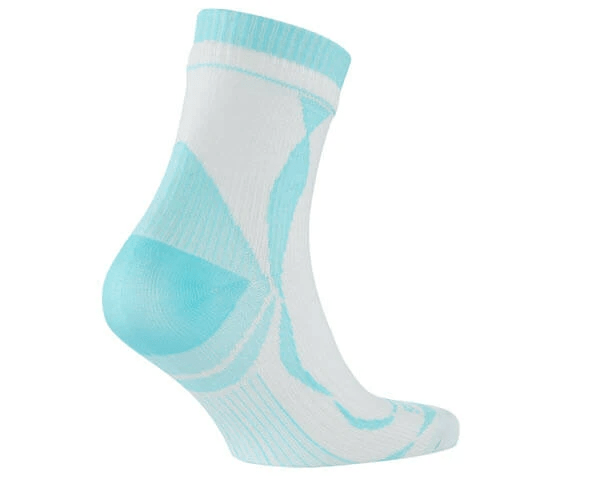
SealSkinz Women's Thin Ankle Length Socks
Test Sock 5)** ArmaSkin Anti Blister Socks
I also tested the Armaskin sock. Armaskin is the inner sock of a double-sock system – the outer sock being any sock of your choice. Although not primarily marketed as a waterproof sock, they claim “The Si fusion polymer coating is macro porous and hydrophobic (water hating) therefore REPELS all MOISTURE away from the skin keeping it drier”. I suspect when they say this they mean they repel perspiration in a moisture-wicking kind of way, because the bucket test showed they certainly didn’t repel water from the outside in any meaningful way.
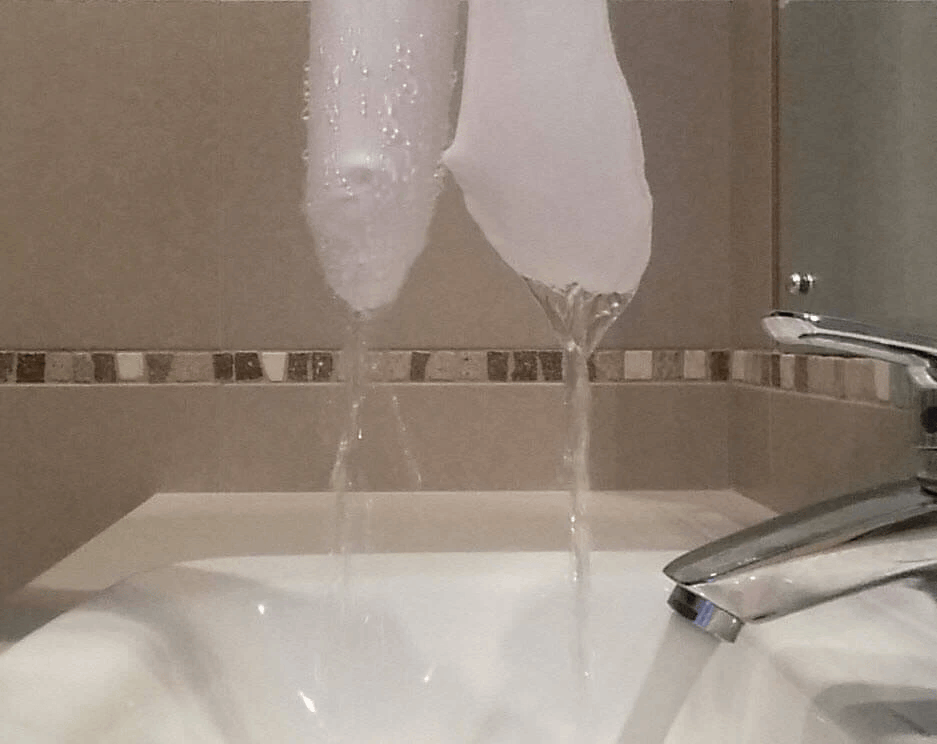
ArmaSkin socks allow water to move freely from inside to out (sweat) and from outside to in (environmental water).
Link: https://www.armaskin.com
Description: “The Si fusion polymer coating is macro porous and hydrophobic (water hating) therefore REPELS all MOISTURE away from the skin keeping it drier.”
Fibre content: 87% polyester 16% Spandex 5% silicone.
Water balloon test: Fail. Water beaded on the inside out sock (on the Si layer) but they are not waterproof – water moved freely from inside to out (perspiration) and from outside to in (environmental water).
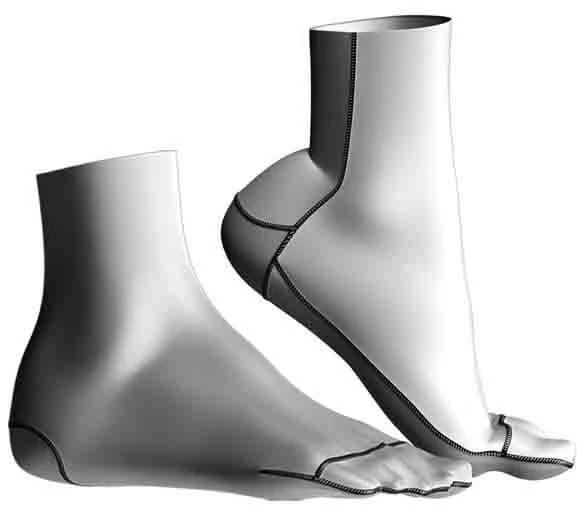
ArmaSkin Anti Blister Socks
Getting back to the definition and function of a waterproof sock … I have assumed it means the sock locks all water out. But do sock manufacturers mean their socks are waterproof, as in they don’t hold any water? Water is free to move in and out, but the sock absorbs next to no water? I tested all the socks for the amount of water they held. Once I tipped all the water out and let it drip for 10 seconds, I wrung it out and captured this water in a container and measured it's volume. I tested separately for the amount of water held by the outside of the sock, and the amount held by the inside of the sock. Plus the total of both. Below are the results of the six socks tested:

Water volume held by tested socks
Comments on the "water balloon test" from Martin (hiker). Thanks Martin!:
“Hi Rebecca. I think your test of the waterproof socks was not completely valid.
The membrane in these things is designed to let water vapour pass but not water. The heat from your body and any friction in the shoe warms sweat inside the sock which then, in vapour form, passes through the barrier membrane to join the colder water on the outside of the sock. Just filling a sock with water will not show the passing outward of water in liquid phase as it will not happen; only vapour passes through. Try soaking a membrane waterproof sock inside and out, then sealing the aperture at the cuff and hanging it out to dry. The sock will dry inside and out, as the vapour passes through the membrane.
In a cold/wet environment I’ve found Sealskinz to be very effective when used in leaking boots, keeping my feet substantially dry (certaily sufficiently dry to avoid trench foot) even when the foot-bed of the boot drips water when removed. I’ve not tried the socks in a warm or hot/wet environment when the termerature differential accross the membrane would be less, which may make the process less effective.
Over-toping and filling the socks with environmental water could prove a problem given the amount of energy required to turn such a relatively large volume to water into vapour.
It is possible to have “waterproof” as well as “breathable” unless one overloads the system.
Regards, Martin”
What are your expectations of a waterproof sock?
3. Water-resistant uppers
Shoes with a water-resistant upper will repel water. That’ll be helpful when running or walking through wet grass and a bit of rain. But water can still get into your shoe to cause maceration:
- Through the eyelets
- Around the tongue
- At the top of the shoe where your foot goes in
Gaiters will help with the third. But in the most water-logging situation of a river-crossing, it’s safe to say it’s almost impossible to keep the inside of your shoe completely dry, even with a water-resistant upper.
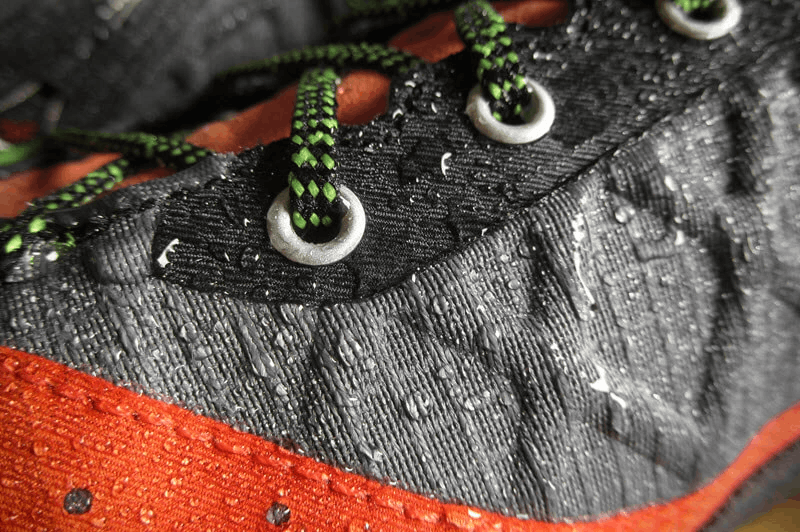
Water-resistant uppers
4. Freely-draining shoes versus waterproof shoes
Some shoes are chosen for their ability to let water easily run out of them, as opposed to being waterproof and attempting to block water out. Philip Werner elaborates on his preferred footwear system for hiking across Scotland through wet and muddy terrain. “While I dearly love my leather Asolo TPS 520s, they take take 4-5 days to dry when they get soaked through. The only viable alternative is to wear a pair of trail shoes that are fast drying, and not lined with a breathable membrane like Gore-tex.” Brian Green highlights the Columbia Drainmaker for this quality. The video below shows how readily water drains out as it's poured in to these shoes.
5. Breathable uppers
Shoes with a breathable upper allow moisture to readily evaporate through to the outside. This enables the all-important moisture gradient to exist so water can continue to be moved away from the skin. Sports shoes with mesh uppers are particularly open and breathable. But the breathable shoes that are so ideal in hot dry conditions provide easier access for environmental water into the shoe. Just as Section Hiker's Philip Werner demonstrates, your decision needs to be based on the conditions you face. He also mentions the use of waterproof Rocky Gore-Tex socks (which I didn't test, unfortunately).
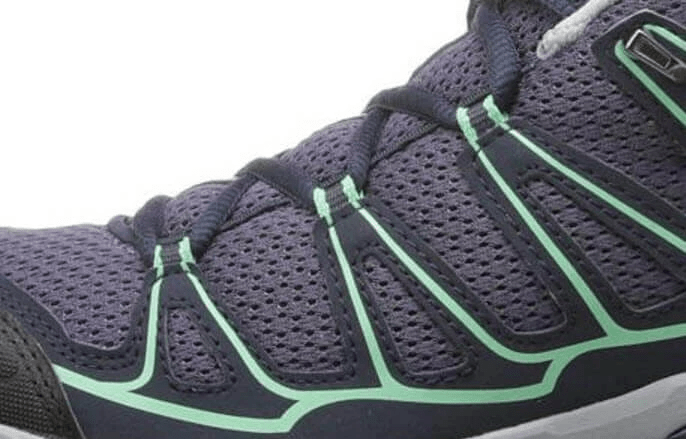
Breathable uppers
6. Don't do this!
Tipping water or squeezing sponges over your head is the most preventable yet overlooked source of maceration. Simply don't do it. But if you have to, do something to stop this water from running down your legs and into your shoes.
An overlooked source of environmental water that can cause macerated feet - Image credit ©IANCORLESS.COM - ALL RIGHTS RESERVED
7. Change to dry shoes and socks
Change out of wet shoes and socks into dry ones when you can. That is, assuming you can carry that extra bulk in your pack, or you can have them delivered to you (or strategically placed) on the course. The only time this might not be of any use is if the environmental water exposure is ongoing (rain, wet grass, river crossings) - five minutes later your footwear may be in the same waterlogged maceration situation.

Drop bags carrying dry shoes and socks, among other things - Image credit highdesertdropbags
8. Let your feet air
A good period of exposure of your feet to the air is an opportunity not to be missed, to lessen the cumulative maceration effect of water exposure. To what degree this is possible will be determined by your event.
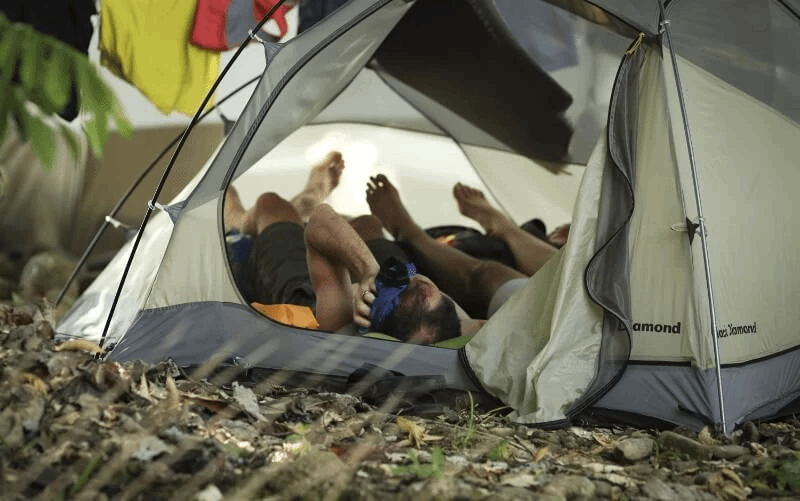
Give your feet the best chance of recovery by exposing them to the air for as long as possible - Image credit ©IANCORLESS.COM - ALL RIGHTS RESERVED
What topical products to put on your skin to keep it dry
Athletes use topical barrier preparations (ointments, creams, lotions, powders, sprays, tapes) in an attempt to keep water away from the skin. Putting maceration to the side for a moment, the prevention of “moisture-associated skin damage” is a topic of interest for parents dealing with nappy rash and nursing staff dealing with urinary incontinence and heavily exudating ulcers (weepy wounds). Products like Desitin Nappy Rash Ointment (aka Desitin Maximum Strength Original Paste) containing 40% zinc oxide have found increasingly popular use in hikers and runners for the management of foot maceration.
Topical preparations come in many forms. Each type has different ingredients (listed) and different effects. Below is an overview with snippets mainly from [this page on Wikipedia](https://en.wikipedia.org/wiki/Topical_medication). As you read through the different formulations and ingredients, think about the ultimate aim in preventing maceration – to keep the skin dry or to have a drying effect. Your topical application is asked to achieve this by satisfying two seemingly mutually exclusive mechanisms - block water from getting onto the skin while allowing it to get out of the skin. Not only that, as an athlete, you need it to stay on the skin during your vigorous activity. That’s a big ask! But let's look at the options.
Topical solutions
Topical solutions are of low viscosity and often use water or alcohol in the base. The solution can cause drying of the skin if alcohol is used in the base. They are usually a powder dissolved in water, alcohol, and sometimes oil. A tincture is a topical solution that has a high percentage of alcohol. Tinctures are typically an extract of plant or animal material extracted by soaking in alcohol. They are often tacky and used as an adhesive enhancer.
- Blister Bomber: Dimethicone, cyclomethicone, dimethiconal, benzyl benzoate, vitamin E, aloe vera.
- 2Toms SportShield (roll on solution): Dimethicone, aloe vera extract, tocopherol (vitamin E).
- Trislide (spray): Dimethicone, cyclopentasilozane, propane and n-butane.
- Blistop (spray): Dimethylether, ethyl acetate, pentane, acrylic co-polymer, menthol.
- Drysol Solution: Aluminium chloride 12% or 20%.
- Sweat Block: 14% aluminium chloride, 0.15% benzoic acid, botanical extracts, eugenol, polyethylene glycol 8000, polyoxethylenesorbitan monolaurate, vitamin E oil, water.
- Compound Tincture of Benzoin: Alcohol, benzoin, aloe,storax, tolu balsam.
- Tuf-foot: Isopropyl alcohol, balsam peru, tincture of benzoin, <5% acetone.
- Mastisol: Gum mastic, styrax liquid, methyl salicylate, SD alcohol 23-A.
Lotions and shake lotions
Lotions are similar to solutions but are thicker and tend to be more emollient in nature than solutions. They are usually an oil mixed with water, and more often than not have less alcohol than solutions. Lotions can be drying if they contain a high amount of alcohol. A shake lotion is a mixture that separates into two or three parts with time. Frequently an oil mixed with a water-based solution, they need to be shaken into suspension before use, hence the instruction "shake well before use".
- Bromi-lotion:Aluminium hydroxychloride in a soothing lotion base.
Creams
A cream is thicker than lotion, and maintains its shape when removed from its container. It tends to be moderate in moisturizing tendency. A cream is an emulsion of oil and water in approximately equal proportions. It penetrates the stratum corneum outer layer of skin wall.
- Ego Silic 15 Cream: Water, dimethicone, cetyl alcohol, glyceryl stearate SE, paraffinum liquidum, glycerine, methylparaben, propylparaben.
- Desitin (described below) is [also sold as a cream](https://www.desitin.com/diaper-rash-products) with 13% zinc oxide.
Ointments
An ointment is a homogeneous, viscous, semi-solid preparation, most commonly a greasy, thick oil (oil 80% - water 20%) with a high viscosity. They are used as emollients or where a degree of occlusion is desired. Ointments are usually very moisturizing, and good for dry skin, but they can interfere with adhesion of tapes and dressings.
- Vaseline: White petrolatum jelly.
- Bag Balm: 8-hydroxyquinoline sulfate 0.3% in petrolatum, lanoline base.
- RunGoo: Water, petrolatum, mineral oil, ozokerite, lanolin alcohol, acacia decurrens / jojoba / sunflower seed wax / polyglyceryl-3 esters, propylene glycol, diazolidinyl urea, iodopropynyl butylcarbamate.
- Aquaphor Healing Ointment: Petrolatum 41%, mineral oil, ceresin, lanolin alcohol, panthenol, glycerine, bisabolol.
- Trail Toes: Petrolatum, beeswax, aluminium starch octenylsuccinate, dimethicone, phenoxyethanol <1%, ethylhexyglycerine.
- Hydropel: Dimethicone, hydrophobic starch (Dry Flo), petroleum jelly (product no longer available).
- Udder Balm: Water, mineral oil, cetearyl alcohol, glycol stearate, stearic acid, glycerine, propylene glycol, sorbitol, lanolin, aloe barbadensis (aloe vera), retinyl palmitate (vitamin A), tocopherol acetate (vitamin E), ergocalciferol (vitamin D2), methylparaben, sodium hydroxide, propylparaben, fragrance, FD&C yellow #5.
- BandAid Friction Block: Hydrogenated vegetable oil, cetyl alcohol, fragrance.
- Gurney Goo: Silicon, other goodies, tea tree oil (10%).
- BodyGlide Anti-Chafe: 0.5% Allantoin, aloe barbadensis leaf juice, caprylic/capric triglyceride, cetearyl alcohol, glyceryl behenate, glyceryl dibehenate, ozokerite wax, stearyl alcohol, tribehenin, tocopherol.
- Gold Bond: Caprylic triglyceride, tribehenin, stearyl alcohol, cetyl esters, polyethylene, zinc oxide, silica, ethylhexyglycerin, aloe vera oil extract, isopropyl palmitate, isopropyl myristate, bisabolol, zingber officinale (ginger) root extract, tocopheryl acetate (283-182).
- Desitin Nappy Rash Ointment: Zinc oxide 40%, preservative methyl hydroxybenzoate, butylated hydroxyanisole.
More on ointments
Woo et al (2009) discuss three different types of ointments: petroleum-based; dimethicone-based; and zinc-based.
- Petrolatum-based products are similar to the zinc-based products except that they have a greater fluid creep into the surrounding skin.
- Petrolatum-based products tend to melt and wash off easily.
- The newer silicone-based ointments (ie: dimethicone) have lower frictional resistance, and are more resistant to wash off.
More on zinc oxide
Let me elaborate a little. Zinc oxide is in both Desitin Nappy Rash Ointment and the "zinc" sunblock you wore to the beach and sports carnivals as a kid. I still use it today, much like Mike Hussey here. Like the sunblock zinc, Desitin 40% is difficult to wipe off. That's an advantage when used on your feet. In contrast, Vaseline wipes off quite easily. I even got some dimethicone in it's pure form from my pharmacist to see how it compared to the others. It looks and feel like an oil, but when you wipe it off, it still feels a bit slippery, like it’s still there without being able to see it. That’s similar to the zinc oxide – it’s really difficult to wipe it off your skin.
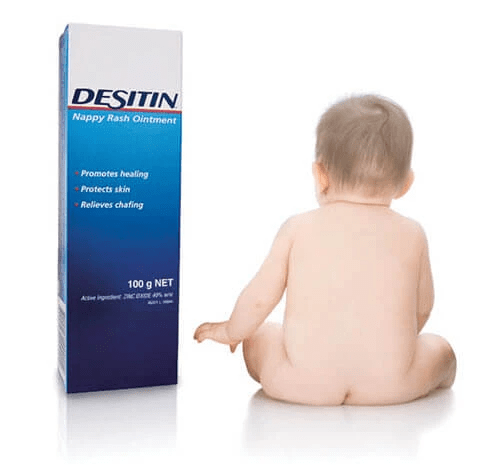
Desitin 40% zinc oxide ointment
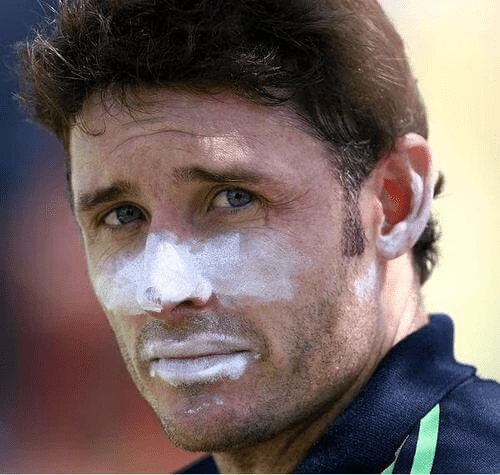
The great man Mike Hussey sporting zinc sunblock
Gels
Gels are thicker than a solution. They are often a semisolid emulsion in an alcohol base. Some will melt at body temperature. Gels tends to be cellulose cut with alcohol or acetone and tend to be drying. They tend to have greatly variable ingredients between brands. Gels carry a significant risk of inducing hypersensitivity due to fragrances and preservatives. A gel is useful for the scalp and body folds. In applying gel one should avoid fissures and erosions due to the drying and stinging effect of the alcohol base.
- No examples
Powders
Powder is either the pure drug by itself (talcum powder), or is made of the drug mixed in a carrier such as corn starch or corn cob powder (Zeosorb AF - miconazole powder). The last example (listed below) contains quite different ingredients compared to the others and seems to be more advanced in its water-repelling ability (watch the video for a demonstration).
- Talcum powder: Pure talc.
- Zeasorb powder: Talc, microporous cellulose, acrylamide/sodium acrylate copolymer, chloroxylenol, imidazolidinyl urea, aldioxa, fragrance.
- Bromi-talc: potassium alum, bentonite.
- Odor Eater foot powder: Zea mays (corn) starch, sodium bicarbonate, sodium polyacrylate (crosslinked), fragrances, tricalcium phosphate, benzethonium chloride).
- Prantal powder: Diphemanil Methylsulfate 20 mg/g .
- 2Toms BlisterShield Powder: PTFE, PE wax.
Pastes
A paste is a combination of three agents - oil, water and powder. It is an ointment in which a powder is suspended.
No examples, although Desitin is also sold as a paste with 40% zinc oxide.
Film forming liquids
“Advances in polymer science have led to the development of a new generation of product, which allow a thin semi-permeable protective silicone-based, polymer coating to be applied to the skin (eg: Cavilon, Secura, LBP)” (Voegeli, ?) Film-forming liquid barriers are clear, breathable films that are flexible and conformable, resist wash-off, provide visualisation of the underlying skin and do not interfere with adhesive tapes/dressings. They come in a variety of application forms such as pads, sticks, and sprays (Woo et al, 2009).
Marathon Liquid Skin Protectant: Cyanoacrylate monomers - video link
Cavilon No Sting Barrier Film: Acrylate terpolymer - video link
Waterproof tapes and adhesive dressings
Some adhesive dressings provide a breathable protective skin barrier. Opsite, for example, is clear and allows visualisation of the underling skin. But as with any tapes and dressings, a constant hindrance is that of dressing edge roll and lifting in high friction areas.
Opsite FlexiFix (or FlexiGrid): Transparent waterproof semi-permeable film with acrylic adhesive. See this link or watch the video below for more information.
How effective can we expect these topical applications to be for mild to moderate maceration?
That is a lot to take in. I don't want to leave you drowning in information overload. To help you navigate through these options, let’s look a little closer at the ingredients and functions of the products and consider their limitations.
a) Hydrophobic
Some ingredients in these products are hydrophobic and some are hydrophilic. Hydrophobic (water-repelling) ingredients include Petrolatum, Mineral oil, Dimethicone, Lanolin, Cetearyl alcohol and Stearyl alcohol. Their water-repelling nature and their delivery (mainly ointments) tends to make them occlusive, or at least semi-occlusive. That means they form a kind of seal over the skin. This is good because it keeps water off the skin. But it’s bad because it inhibits perspiration from escaping from the skin, leaving the skin somewhat weaker. However, thinking back to the start of this article, if the theory of perspiration being the lesser of two evils holds true, the downside of locking moisture in might be surpassed by the benefits of locking water out.
One thing's for sure, though. Although this article is exclusively about prevention, I would not use anything occlusive in the treatment of maceration, for reasons that should now be clear.
b) Hydrophilic
Some ingredients are hydrophilic (water-attracting). That means they bring water into the skin and hold it there. This includes Propylene glycol, Glycerine (Glycerol), Allantoin, Potassium alum, Tribehenin and Aluminium chloride (Aluminium chlorohydrate). The first two are especially water-attracting. Called humectants, these hygroscopic liquids work by:
- Attracting water from the dermis into the epidermis, increasing the water content in the epidermis.
- When humidity is higher than 70 percent, humectants can also attract water from the atmosphere into the epidermis, increasing the pliability and flexibility of the skin, preventing it from cracking.
- Promoting consistent desquamation (shedding of the outer layer of skin) by degrading the corneodesmosomes that hold skin cells together.
These are benefits to dry skin. They’re not beneficial if your aim is to keep the skin dry. Again, although this article is exclusively about _prevention_, I would not use anything hydrophilic in the treatment of maceration, for reasons that should now be clear.
c) Durability and longevity
Let’s assume all of these products provide the perfect mechanical and/or pharmacological effect required to prevent maceration on the feet. Now consider their durability during prolonged athletic situations. It seems self-evident that anything on the skin will be gradually massaged into the sock with walking and running. And will become diluted by the very moisture they're attempting to combat, particularly those that are water-soluable.
Step by step, less product will be left on the skin, where it’s needed. How long do you expect your topical product to last? How often will you need to reapply it for the effect to remain? With some ingredients more durable than others, which products are more worthy of your consideration?
d) Antiperspirants
Antiperspirants plug the sweat gland, preventing sweat from escaping from the skin. They don’t prevent the production of sweat – it stays trapped within the skin. While this might not be such a big deal for your underarm area, the shear forces your feet deal with are significant. Weakening of the skin renders it less able to remain intact under these shear forces.
“Aluminium chlorohydrate and aluminium zirconium tetrachlorohydrate gly are the most frequent active ingredients in commercial antiperspirants. Aluminium-based complexes react with the electrolytes in the sweat to form a gel plug in the duct of the sweat gland. The plugs prevent the gland from excreting liquid and are removed over time by the natural sloughing of the skin. The metal salts work in another way to prevent sweat from reaching the surface of the skin: the aluminium salts interact with the keratin fibrils in the sweat ducts and form a physical plug that prevents sweat from reaching the skin’s surface. Aluminium salts also have a slight astringent effect on the pores; causing them to contract, further preventing sweat from reaching the surface of the skin.” https://en.wikipedia.org/wiki/Deodorant
e) Tinctures and their tackiness
Tinctures are used for their ability to form a film over the skin as they dry. But they tend to be sticky, which is why they’re used as adhesive enhancers. While the advantage of the film barrier is evident when completely dry, the feet are truly dry for a very short time only. Moisture from perspiration will make the film tacky – a problem as it may lead to either grit and debris sticking to the skin and/or blisters.
One of the most widely-known tinctures is Compound Benzoin Tincture (TBCo or Friar's Balsam). There is a little confusion around this product that I can shed some light on, in case it helps:
"Benzoin is unrelated to benzoin resin or TBCo. Benzoin resin is commonly called benzoin (but is not the chemical compound of benzoin) and is also called gum benzoin or gum Benjamin. Tincture of benzoin is a pungent solution of benzoin resin in alcohol. A similar preparation called Friar's Balsam or Compound Benzoin Tincture (USP) contains, in addition, Cape aloes and storax (liquidambar resin)."
f) Powders and moisture
At first glance, there are two reasons why this base ingredient is a good thing. Firstly, talcum powder acts as a dry lubricant and while everything stays dry, it forms a low friction layer on the skin. Secondly, it soaks up moisture. The problem is, it doesn’t take much moisture, only 13-17% for the two to combine and form a paste (Comaish and Bottoms, 1971). A paste will neither keep things dry nor soak up any more moisture. In fact, it becomes abrasive and damaging to the skin. However, there is one powder I looked at that contains a different type of powder of PTFE and PE wax. That was 2Toms BlisterShield Powder - here's the video if you didn't see it earlier:
g) Lubricants and traction
Many of the topical products listed are lubricants. Lubricants reduce friction markedly, in the short term. During this time, they result in a lack of traction for your foot in your shoe. This is not good because it reduces the functional efficiencies of gait and can predisposes to injury. If your foot is sliding around in your shoe, you are less stable on your feet. Ankle sprains, black toenails and proximal muscle strains are all more likely, not to mention reduced propulsive force.
What does the perfect maceration prevention strategy look like?
It depends.
Is it hot, cold or somewhere in between? If it’s hot and your feet perspire a lot, you may prioritise a thin moisture-wicking socks and breathable shoe uppers. If it’s cold, thermal insulation may dictate a thicker sock to be most important and breathable uppers less important.
Is it dry, wet or are you going to get saturated? If it’s dry, it could be as easy as a breathable shoe and moisture-wicking socks. Or if it’s a little wet, you may need to add in an occasional shoe/sock change to prevent skin maceration and making sure to air your feet for a time. If your feet are going to get saturated, you might need to rethink the ability of your shoes to drain and/or wear a pair of waterproof socks.
Is your event a few hours, a few days or a week long? Do you have lengthy rest breaks, is it non-stop or something in between? Do you have access to a lot of extra gear, have you got crew or drop bags, or are you carrying everything on your back? This has implications for your ability to air your feet out and in changing into dry footwear.
Conclusion
Keeping your feet dry is a tough gig. In pursuit of this goal of preventing skin maceration, you need to decide on one of the following objectives:
- Somehow keep all water out of your shoe and/or sock
- Concede that water will get into your shoe and/or sock (and more or less stay in), but somehow keep it off your skin
- Let the water come into your shoe and/or sock, but let it escape just as quickly
